Those who have experienced the intense burning, itching pain on their skins that may last for days, or have had an allergic reaction after stepping on or touching it by mistake, will probably know the answer right away.
They may even have had to get an antibiotic from their doctor to stop the hot, red tenderness and swelling caused by the rapidly spreading rash after turning into cellulitis.
A few more clues for those who are lucky enough not to have encountered it:
- You will find it in Louisiana, Kansas, Arkansas, Oklahoma, the northeastern state of Tamaulipas in Mexico, and Texas.
- It grows on dunes, along riverbanks, on dry pastures, old fields, and flood plains.
- You will find it among trees and in woods, on sunny descents, and it loves sandy, loose soil.
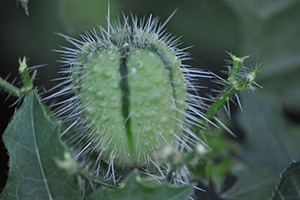 The hairs on the leaves and stems behave like needles when they connect with your skin, and their spikes deposit the chemicals that cause a stinging rash.
The hairs on the leaves and stems behave like needles when they connect with your skin, and their spikes deposit the chemicals that cause a stinging rash.- It gets much worse when you touch, rub, or scratch it, as doing so pushes the chemicals deeper into the skin.
Rio Grande wild turkeys, mourning doves, quail, and songbirds love to eat the seeds, and it attracts insects such as butterflies, beetles, and bees.
How to Identify a Bull Nettle Plant
Very carefully. Watch out for this herbaceous, perennial, drought-tolerant plant during the summer months when you get out of your ATV, play golf, go hiking, camping, or are mowing your yard or fields. The spines can even penetrate clothing if there is enough pressure.
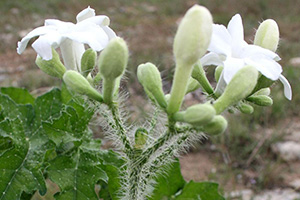
The bull nettle flowers in early spring and into mid-summer. It can bloom throughout the year in the southernmost regions and from March to November further north.
Hairs cover the two- to six-inch-long green, crinkly-looking leaves.
Each leaf divides into three to five irregularly or toothed leaflets or lobes, and they appear off and on along the stem, which releases a milky sap when broken.
Related: The Toothache Plant That Every Prepper Should Grow
Every plant presents fragrant, white, round, separate but concurrent male and female flowers clustered on a stem consisting of a main bough or complex assembly of branches. The flowers comprise five to seven lobed sepals that look like petals covered with hispid hairs.
Each flower has a three-lobed pistil, ten or more stamens, and large, fragile pollen.
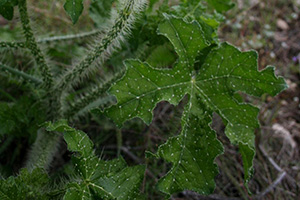
The bull nettle has a deep taproot and branching stems that grow up to 40 inches long. Three or four distinct compartments secured by a round, tough, prickly seedpod contain the fruits or seeds. The fleshy outside part shrinks to reveal the hardy shell holding the four compartments when the seeds mature.
Each pod contains three cylindrical, brownish-white, smooth, half- to three-quarter-inch long seeds.
Why Does the Bull Nettle Hurt so Bad?
The hairs on the bull nettle release an allergen or toxin when it touches your skin. Its fine hairs are a medium into the epidermal and dermal skin layers for the secretions the plant discharges. The spikes emit corroding irritants as they break off inside the skin.
If an animal makes oral contact with the plant, it will salivate profusely and rub its mouth.
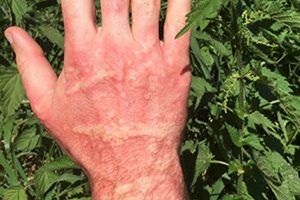 Do not touch the area where you have brushed the bull nettle for at least ten minutes. You will be able to remove the poisonous chemical easier if you let it dry first. Rubbing or touching will exacerbate the stinging, burning, and itching rash and cause the effects to last longer than usual.
Do not touch the area where you have brushed the bull nettle for at least ten minutes. You will be able to remove the poisonous chemical easier if you let it dry first. Rubbing or touching will exacerbate the stinging, burning, and itching rash and cause the effects to last longer than usual.
Wash the toxin with soap and water after ten minutes to reduce the painful swelling and redness. Use a clean cloth to wipe the area properly if you do not have these available.
You want to use durable masking or duct tape to remove the spikes from your skin as soon as possible. Try wax hair removal strips for faster relief if the adhesive tape does not work. The effects may last for 24 hours or longer.
Juices from the dock or jewelweed plants that often grow near the culprit may provide relief. Crush the big, oval-shaped dock leaves with red stems, wavy edges, and rounded tips and apply them to your skin. You can identify jewelweed by its yellowish-orange trumpet-shaped flowers and egg-shaped leaves with serrated edges and smooth, dull upper surfaces.
Related: How to Make a Natural Remedy for Food Poisoning
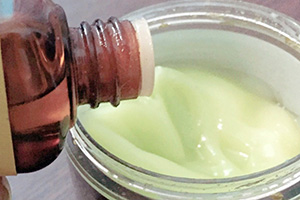 Other remedies include dabbing on – rather than rubbing – a weak ammonia solution, Windex, tobacco, spit, urine, apple cider, vinegar, or aloe vera. You can try a paste consisting of baking soda and water three or more times a day for 30 minutes at a time until it does not burn or itch any longer.
Other remedies include dabbing on – rather than rubbing – a weak ammonia solution, Windex, tobacco, spit, urine, apple cider, vinegar, or aloe vera. You can try a paste consisting of baking soda and water three or more times a day for 30 minutes at a time until it does not burn or itch any longer.
Cold compresses may also help, as may OTC hydrocortisone cream and insect sting creams or wipes. We cannot guarantee that all the above suggestions will be successful, however.
Beneficial Uses for the Bull Nettle
The edible seeds scatter when they are ripe, and the pod bursts open, propelling them away from the plant. The Native American peoples harvested and consumed them, and you can still do so today.
Related: 5 Poisonous Plants That Can Be Used As Medicine When SHTF
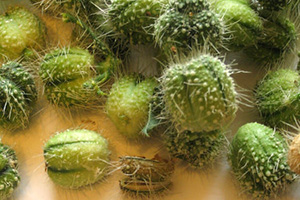
To prevent injury while collecting, you need thick gloves, boots, a long-sleeved shirt, long pants, and tongs to pick up the pods.
Drop the seedpods into a paper bag, wait for them to ripen and burst open, then collect the appetizing, nutty-flavored seeds and eat them raw or roast them.
Dig up the large roots with a shovel, starting further away from the plant than you might think. Cut and clean it from the part above ground and peel the bark off.
You can boil, bake, or roast the taproot as you would a potato or do so twice as you need to when making poke salad. The center is inedible and fibrous.
Now You Know Which is the Most Painful Plant in the US
You may want to get rid of these resilient, invasive plants on your property and are in for a battle. There are not many options when it comes to controlling, killing, or eradicating the bull nettle.
You can try digging down to the top of the taproot and place a number ten tin over it. Push it down and cover it over. You may end up with a field full of underground cans because the plants will grow back if you remove them. Another option is to use chemicals, which may not be your preference.
Texas Cooperative Extension and the Texas Agricultural Experiment Station professionals have created, evaluated, and endorsed two three-step, convenient, effective, and environmentally responsible practices to control the Texas Bullnettle.
You can treat a large infestation with the ground broadcast spray method and smaller or scattered penetrations with the individual plant leaf spray method. You will need to repeat the treatments until you get the problem under control as the seeds spread, and you will need to stamp out the new seedlings. It would help if you got rid of plus-minus seven out of every ten plants.
You may also like:
 How to Safely Store Homemade Broth for 6 Months
How to Safely Store Homemade Broth for 6 Months
10 Medical Supplies You Need To Stock Up Before It’s Too Late (Video)
Everyday Safety Tips – Part 1: ATM Money Withdrawal
You’ll Probably Catch One of These 5 Infections When The SHTF

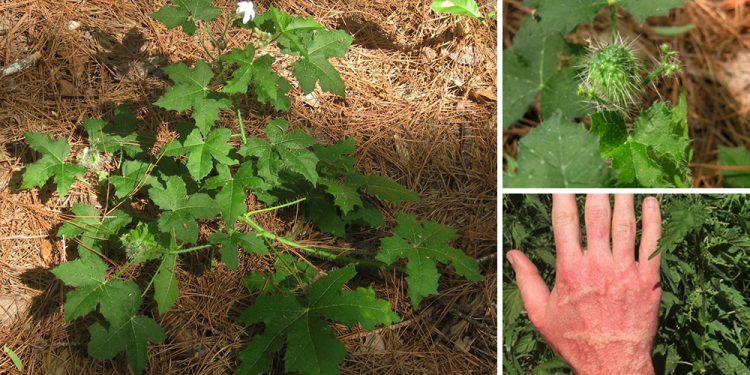













Wow!
And I thought Stinging Nettles were bad.
How prevalent is this plant N.E. Florida, as we have got plenty of loose sand here ?
Ouch. Just the same, if they taste as good as stinging nettles, I’ll eat them. niio
https://questionerlab.com/can-you-eat-bull-nettle
As you are on this subject, you should bring attention to the Giant Hogweed, a very dangerous plant that is spreading throughout the US. If you get the sap on you, in that area, if affects your DNA to resist Ultraviolet rays (UV), as in sunlight. You will get severe burns and sometimes blindness. Google it to get many links but a good one is: https://www.goodhousekeeping.com/home/gardening/a21598753/giant-hogweed/. Be aware and avoid this at all costs.
Cows won’t eat em.
Got a couple pastures here in central Florida and you’ll see these demon plants thriving.
Heard on YouTube even torching them is dangerous from the fumes.
We call it pigweed and our proposed practically taken over by it when we moved in. It did not take but a few years for our goats to clear it out. They say it’s poisonous to livestock but whenever I put the goats in another field, it was the first thing they went for.
Its smaller relative, wild parsnip/cow parsnip/blisterweed, has taken over the roadsides of Vermont and upstate portions of New York. Its bracts of flowers are yellow-green instead of white like Giant Hogweed. It is just as dangerous. And to be clear, it is UV from the sun that activates the poison. If one gets juiced in dark cloud or darkness situations, just wash thoroughly and you’re good. The blisters persist for a long time, often for a year before healing and blindness is a distinct possibility. Why Vermont let it get this bad, one cannot answer but Maryland, PA and NJ seem to respond to eradicate it. It loves the disturbed soil of roadsides. The roots are parsnips and delish. Note that celery in the field can cause similar problems and long gloves are a definite harvesting accessory.
Bull nettle grows in overgrazed Texas pastures, for some reason Texas stockmen have always overgrazed. Adults used to warn us about bull nettle, being kids we ignored them and got into it frequently. It ain’t so bad, if nettles bother you you aren’t going to go far in this life. There is an aggravating nettle I encounter gardening, it is a small low growing trailing plant that is easy to miss and I’m always grabbing it when pulling weeds. I recommend brushing against blind prickly pear while hiking in shorts if you want aggravation worth writing about.
* Note
Do NOT use for toilet paper.
Thank you,
That is all
Your: I take it, it ranks right up there with cactus and poison oak 🙂 niio
How do I kill bind weed and keep it out of the garden????!!!
It’s driving me crazy. Other than roundup, I have tried running the chicken tractor over it and it keeps coming up…..it’s like I’m just fertilizing it.
Use 24-D. Available most anywhere, Walmart, Amazon, etc.
great
This plant is actually painful, if you stay away from it you will not be in any danger. If you try to touch it, the thorn attached to them will bite you causing pain. As you are lacking, I will suggest you this Snoop Dogg Blue Bandana Tracksuit https://www.hleatherjackets.com/product/snoop-dogg-super-bowl-halftime-tracksuit/ which will benefit you.
We follow the newest trends in fashion and are quite curious about clothing. The best website for leather clothing is Jacket Ware.